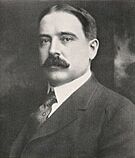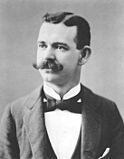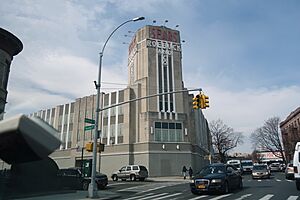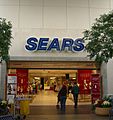Sears facts for kids
 |
|
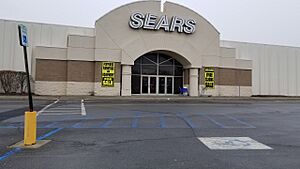
The Sears store at the Hudson Valley Mall in Kingston, New York, holding a liquidation sale in March 2018. It features the logo used from 1984 to 1994.
|
|
| Subsidiary | |
| Traded as | NYSE: S (1906-2005)
DJIA component (1924-1999) S&P 100 component (until 2005) S&P 500 component (until 2005) |
| Industry | Retail |
| Founded | 1886 (as R.W. Sears Watch Company) 1892 Chicago, Illinois, U.S. |
| Founders | |
| Headquarters |
,
U.S.
|
|
Number of locations
|
7 (2025) |
|
Area served
|
United States |
| Products |
|
| Revenue | |
|
Operating income
|
|
| Parent |
|
| Subsidiaries | Sears Puerto Rico (1937–2025) |
Sears, Roebuck and Co., usually called Sears, is an American company that runs department stores and sells things online. It was started in 1892 by Richard Warren Sears and Alvah Curtis Roebuck. It began as a company that sold items through catalogs by mail. Later, in 1925, Sears opened its first physical store in Chicago.
For many years, through the 1980s, Sears was the biggest store chain in the United States. In 2005, another big store chain called Kmart bought Sears. They joined together to form Sears Holdings. However, over time, Sears faced challenges and its sales went down. In 2018, the company had to file for bankruptcy. After this, a smaller number of Sears stores remained open.
Sears used to have its main office in the famous Sears Tower in Chicago from 1973 to 1992. Then, it moved to Hoffman Estates, Illinois. By 2025, only a few Sears stores are still open in the United States and Puerto Rico.
Contents
History of Sears
How Sears Started
Richard Warren Sears was born in 1863. He started his first business in 1886. He bought a shipment of watches that a jeweler didn't want and sold them for a profit. This led him to start a mail-order watch business called the R.W. Sears Watch Company.
In 1886, he met Alvah Curtis Roebuck, who repaired watches. They moved their business to Chicago in 1887. They published their first catalog, which sold watches, diamonds, and jewelry.
In 1889, Sears sold his business. But he came back to Chicago in 1892 and started a new mail-order company with Roebuck. On September 16, 1893, they officially named their company Sears, Roebuck, and Co. They began selling many different kinds of products in their catalogs.
Before the Sears catalog, people in rural areas often bought things from local stores. These stores had fewer choices and sometimes higher prices. Sears changed this by offering a huge variety of products at clear prices in their catalogs. This was very helpful, especially for farmers.
By 1894, the Sears catalog was 322 pages long. It included new items like sewing machines, bicycles, and even automobiles. By 1895, the catalog grew to 532 pages. Sales increased a lot during these years. By 1896, they added dolls, stoves, and groceries.
Even with good sales, the company faced money problems in 1895. Roebuck decided to leave the business. Sears then brought in two new partners, Aaron Nusbaum and Julius Rosenwald. In 1895, they bought Roebuck's share of the company.
Growing in the Early 1900s
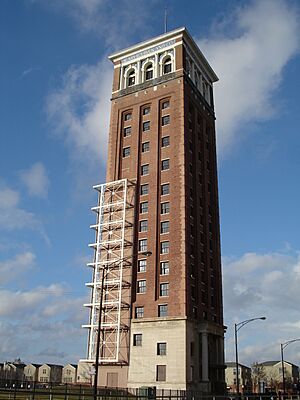
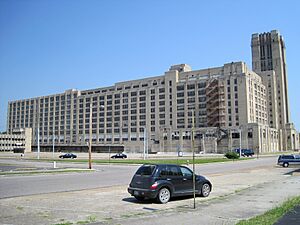
Sears and Rosenwald worked well together. Rosenwald helped the company grow by adding many more products. These included clothes, home goods, tools, and almost anything a family might need.
The company's sales kept growing. In 1906, Sears and Rosenwald decided to offer shares of the company to the public. This meant that people could buy parts of the company. Sears, Roebuck and Company became a public company in New York. This was a big step for a retail company at that time.
In 1906, Sears opened a large catalog plant and the Sears Merchandise Building Tower in Chicago. This huge complex was where the company's offices and mail-order operations were located. It was the main headquarters until 1973.
By 1907, the company's yearly sales reached about $50 million. Richard Sears left his role in 1908 due to health reasons. Julius Rosenwald then became the president and chairman.
Sears faced a tough time between 1919 and 1921 because of a big economic downturn. To help the company, Rosenwald used $21 million of his own money. By 1922, Sears was financially stable again.
Sears' Best Years
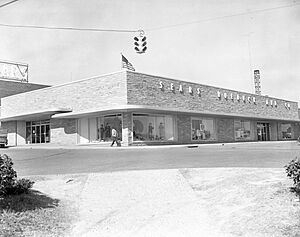
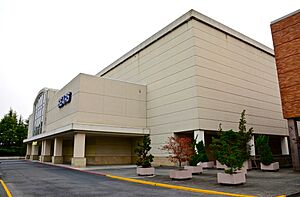
Opening Physical Stores
Julius Rosenwald decided that Sears should focus more on cities. He opened the first Sears department store in 1925 in Chicago. This was an experiment, but it was very successful. Soon, dozens more stores opened across the country. Many of these stores were built near the company's mail-order offices.
Sears stores were different from other stores at the time. They were often built away from busy city centers, in neighborhoods where their customers lived. They also had plenty of free parking, which was great for people who drove cars. Their designs were modern and focused on making shopping easy.
Sears was also one of the first to create department stores that appealed to both men and women. They sold tools and building materials, not just clothes. Customers could also pick out items themselves without needing a clerk to help them.
The Famous Catalog
In 1933, Sears started publishing its special Christmas catalogs, known as the "Sears Wishbook". These catalogs were full of toys and gifts. From 1908 to 1940, the catalog even included ready-to-assemble Sears Catalog Home kit houses that people could order and build themselves!
International Growth
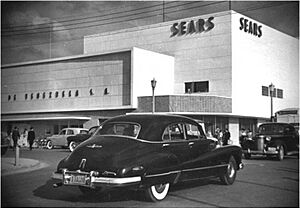
Sears expanded beyond the United States. It opened a small store in Havana, Cuba, in 1942. In 1947, Sears opened its first store in Mexico City. The Mexican stores later became a separate company called Sears Mexico.
Over time, Sears opened stores in many countries in Central and South America. As of 2025, Sears still operates in Mexico, Guatemala, El Salvador, and Puerto Rico.
Expanding Products and Services
From the 1920s to the 1950s, Sears built many large department stores. These stores became more important than the mail-order business. After World War II, Sears expanded into suburban areas and shopping malls.
Sears also started to offer new services and products. In 1931, it created Allstate Insurance Company. Sears also developed its own popular brands like Kenmore (for appliances), Craftsman (for tools), and DieHard (for car batteries).
Peak in the 1970s
Sears was at its strongest in the 1970s. In 1974, Sears finished building the 110-story Sears Tower in Chicago. It became the tallest building in the world at that time. Sears sold the tower in 1988 but kept its name until 2009.
The Sears catalog was so important that it was sometimes called "the Consumers' Bible." It was especially vital for people in rural areas who didn't have many local stores. For many rural African-Americans, the Sears catalog offered a way to buy goods fairly, avoiding problems they might face in local stores during the Jim Crow era.
However, as more people moved to cities, the catalog business faced competition from city department stores.
Sears' Decline
In the 1980s, Sears started to try new things outside of retail. It bought financial companies like Dean Witter and Coldwell Banker. It also launched the Discover credit card. Some people believe these new ventures made Sears lose focus on its main retail business. This allowed other stores, like Walmart, to grow and become bigger. Walmart passed Sears as the largest retailer in the U.S. in 1990.
In the 1990s, Sears began selling off many of these non-retail businesses. The cost of printing and sending out the huge general merchandise catalog became too expensive. Sales and profits went down. Sears stopped printing the main catalog in 1993. This led to many job losses. In 1992, the company reported a very large financial loss.
In 2003, Sears sold its U.S. credit card operations to Citibank. On November 17, 2004, Kmart Holdings Corporation announced it would buy Sears for $11 billion. This created the new Sears Holdings Corporation. The new company said it would keep both Sears and Kmart stores open.
By 2010, the company was no longer making a profit. From 2011 to 2016, it lost billions of dollars. The number of Sears stores dropped from over 3,500 in 2010 to 695 in 2017. Sears tried to improve by selling off parts of its business, like Lands' End and its share in Sears Canada. It also sold its famous Craftsman tool brand to Stanley Black & Decker. In 2017, Sears and Whirlpool, a major appliance maker, ended their long partnership.
Bankruptcy and Today
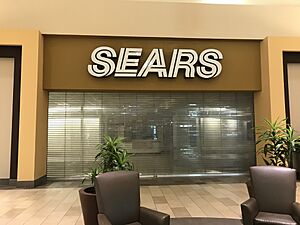
On October 15, 2018, Sears Holdings filed for Chapter 11 bankruptcy. This meant the company needed help to reorganize its debts. In January 2019, Sears announced that it would stay open after its chairman, Eddie Lampert, won an auction to buy the company. This plan saved about 425 stores, including 223 Sears stores, and 45,000 jobs.
In April 2019, Sears opened a few new, smaller stores called Sears Home & Life. These stores sold a limited selection of items. In June 2019, the company announced that Transform Holdco would buy Sears Hometown & Outlet Stores. More stores continued to close throughout 2019, 2020, and 2021.

In September 2021, only 35 Sears stores were left. More closures were announced, including the last Sears store in New York City. In December 2021, Transformco announced plans to sell the large Sears headquarters in Hoffman Estates.
In January 2022, Sears closed its remaining 15 Sears Auto Centers in the United States. In May 2022, about 100 more Sears Hometown stores closed. In December 2022, Sears Hometown filed for bankruptcy, and all its remaining stores were closed.
As of August 2025, there are only five Sears stores remaining open in the mainland U.S. and one in Puerto Rico. The company's website, Sears.com, is still active for online shopping. The Sears stores in Whittier, California, Burbank, California, and San Juan, Puerto Rico are expected to close during the summer of 2025.
Sears' Brand and Business
Company Logo
Sears has changed its logo several times throughout its history. The logos show how the company's look has evolved over the years.
Sponsorships and TV Shows
Before its bankruptcy, Sears supported many events and TV shows.
From 2006 to 2020, Sears had the naming rights for an arena in Hoffman Estates, which is now called the Now Arena.
The company also sponsored the TV show Extreme Makeover: Home Edition. For many years, The Sears-Roebuck Foundation helped fund the PBS children's television series Mister Rogers' Neighborhood.
Through its Sears Auto Centers, the company sponsored some car racing events. It was also the main sponsor for the NASCAR Truck Series from 1995 to 2008, using its Craftsman brand name.
Working at Sears
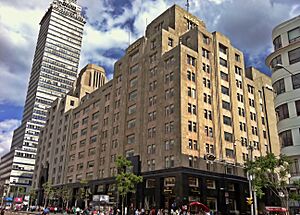
Sears has faced some challenges with its employees. In 1992, the company changed how it paid some workers. Instead of a regular hourly wage, many employees started getting a lower base pay plus a commission (a percentage of their sales). Sears said this change was needed to compete better.
In 2019, Sears announced it was ending life insurance benefits for many of its retired employees. This caused concern among the retirees.
Data Security
2017 Data Issue
Between September and October 2017, there was a problem with the computers used for Sears.com and Kmart.com. Some credit card information from about 100,000 customers was exposed. Sears announced this issue in April 2018.
2021 Data Issue
In 2021, someone unauthorized accessed computer servers belonging to Transformco, the parent company of Sears. This affected employee payroll and healthcare information for current and past Sears employees.
Leadership of Sears
Presidents
- Richard Warren Sears, 1886–1908
- Julius Rosenwald, 1908–1924
- Charles M. Kittle, 1924–1928
- Robert E. Wood, 1928–1939
- Thomas J. Carney, 1939–1942
- Arthur S. Barrows, 1942–1946
- Fowler B. McConnell, 1946–1958
- Charles H. Kellstadt, 1958–1960
- Crowdus Baker, 1960–1968
- Arthur M. Wood, 1968–1973
- A. Dean Swift, 1973–1981
- Edward R. Telling, 1981–1982
- Archie Boe, 1982–1986
- Richard M. Jones, 1986–
Chairmen of the Board
- Julius Rosenwald, 1924–1932
- Lessing Rosenwald, 1932–1939
- Robert E. Wood, 1939–1954
- Theodore V. Houser, 1954–1958
- Fowler B. McConnell, 1958–1960
- Charles H. Kellstadt, 1960–1962
- Austin T. Cushman, 1962–1967
- Gordon M. Metcalf, 1967–1973
- Arthur M. Wood, 1973–1978
- Edward R. Telling, 1978–1981
- Edward A. Brennan, 1981–1982
- Edward R. Telling, 1982–1986
- Edward A. Brennan, 1986–1995
Images for kids
-
Mall entrance to the Sears store at Plaza del Norte in Hatillo, Puerto Rico, in 2011. This store closed in April 2021.
-
Sears Auto Center at Steeplegate Mall in Concord, New Hampshire, in 2017. The Auto Center and the main store at this location closed in February 2020.
-
Exterior of the Sears at the Westfield Hawthorn in Vernon Hills, Illinois, in 2006. This location closed in September 2018 and was demolished in 2021.
-
Mall entrance to the former Sears at Paramus Park in Paramus, New Jersey, in 2009. This location closed in 2018.
-
Exterior of the Sears Essentials in Palm Springs, Florida, in 2010; later reopened as Sears Outlet and closed once again
-
2013 photo of the mall entrance to the Sears Grand at Pittsburgh Mills in Tarentum, Pennsylvania. This Sears closed in January 2015.
-
Exterior of the Sears Parts & Repair Store in Brooklyn, Ohio, in 2012
See also
 In Spanish: Sears para niños
In Spanish: Sears para niños
- Gala-Sears – a former unit in Chile
- Retail apocalypse
- Sears Canada – a former unit in Canada
- Sears Mexico – the Mexican unit, owned by Grupo Carso
- Sears plc – a former UK company not related to the U.S. Sears
- Sears Puerto Rico – the Puerto Rican unit, soon to close


